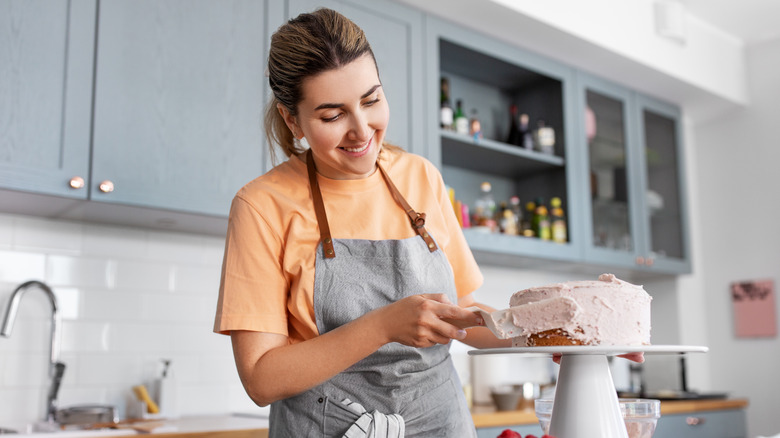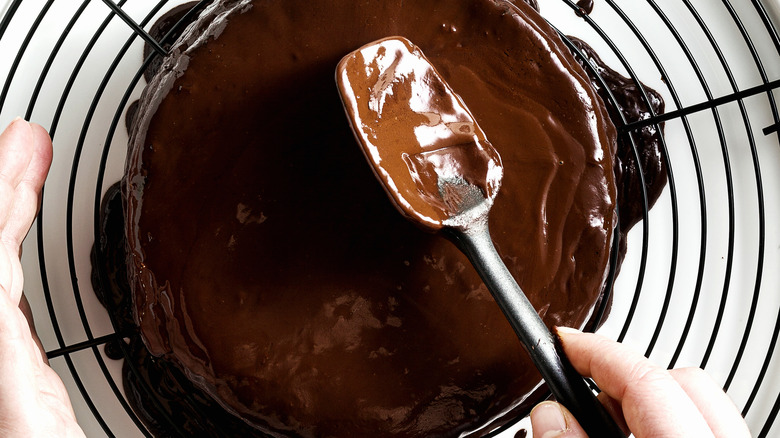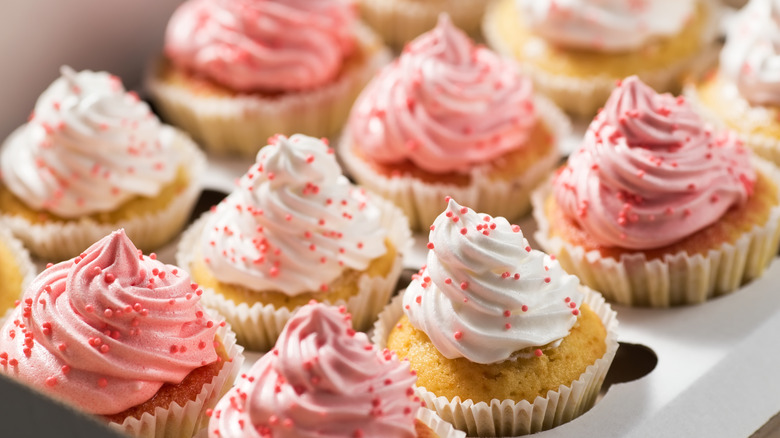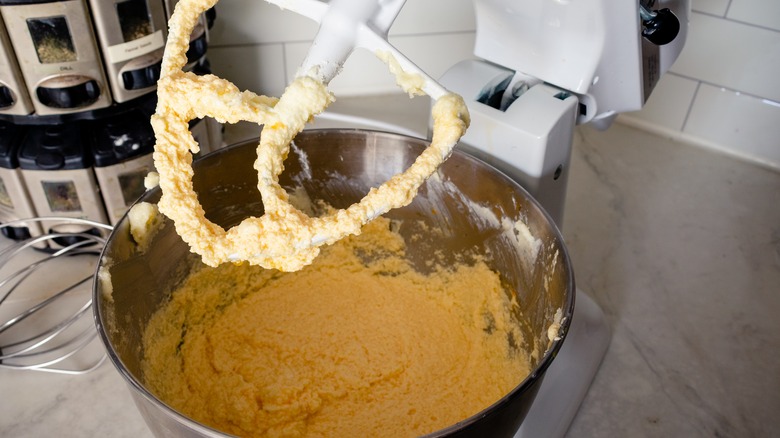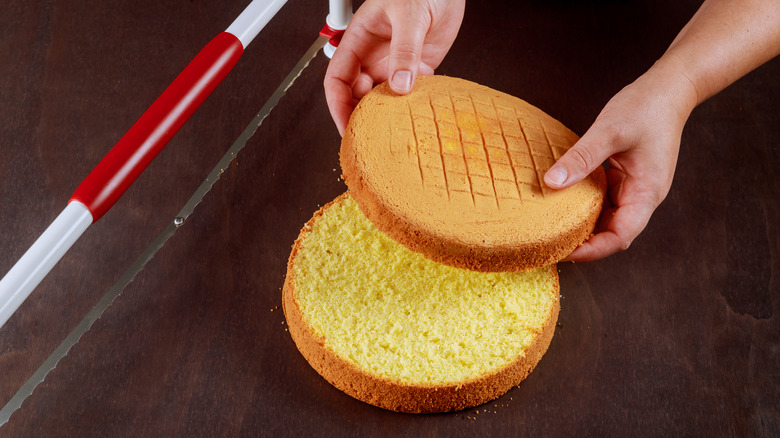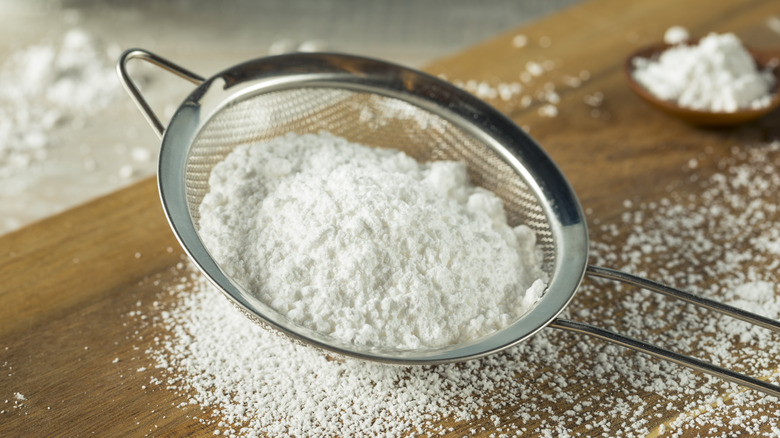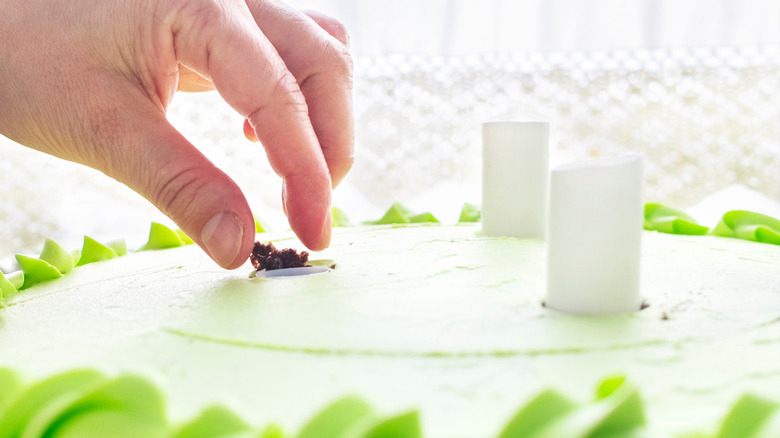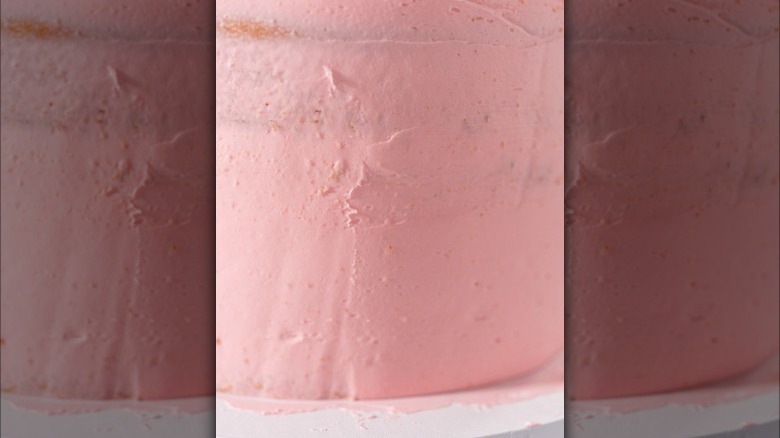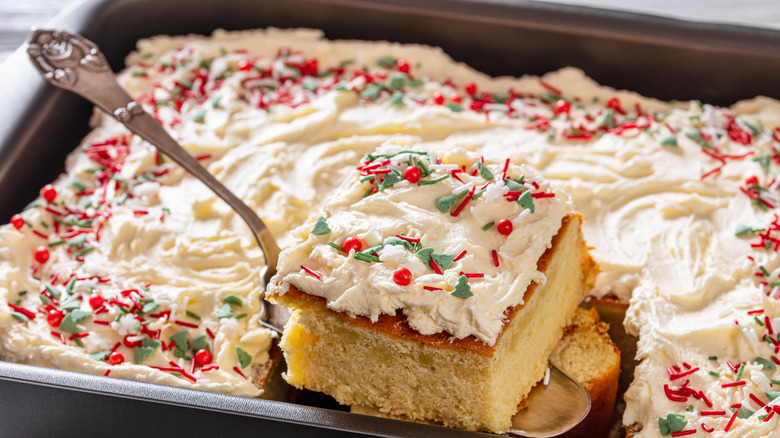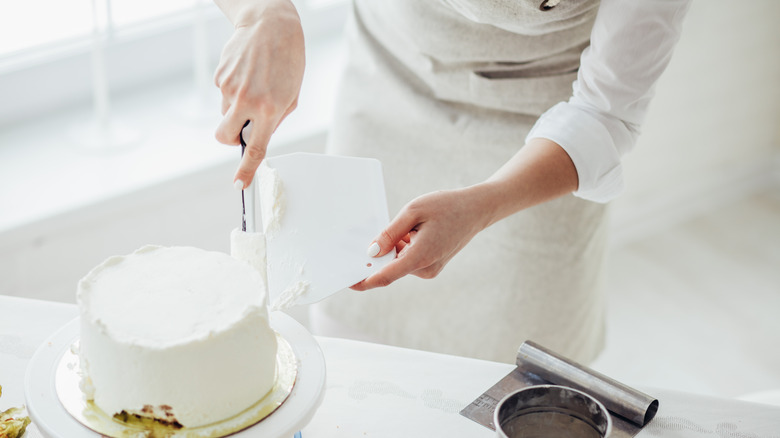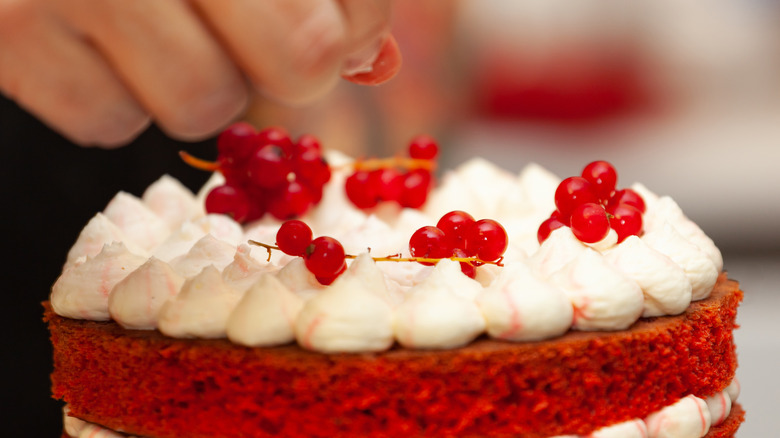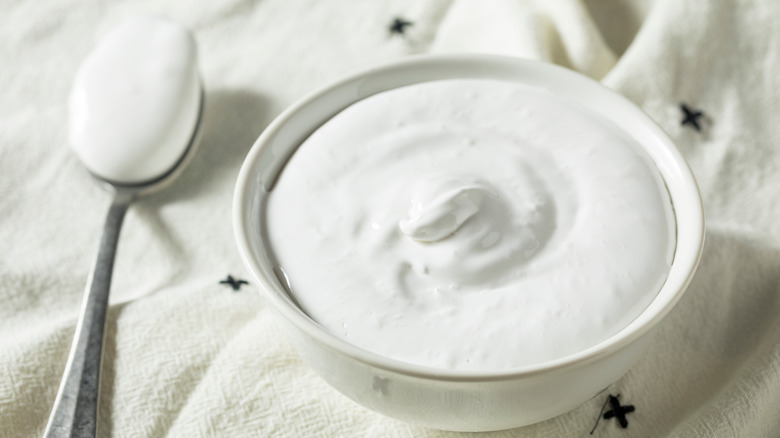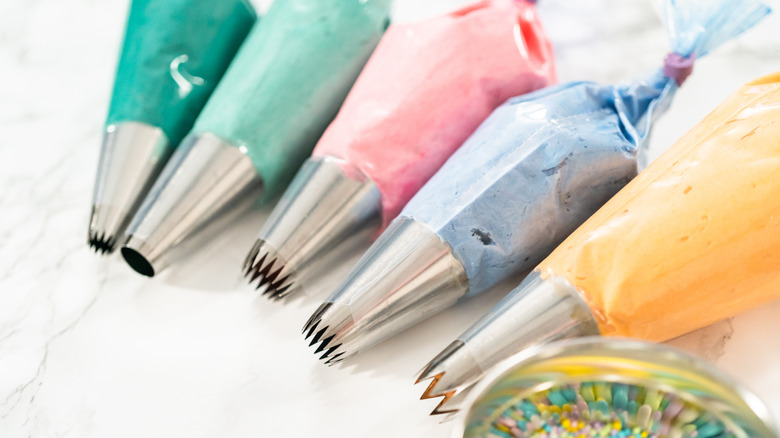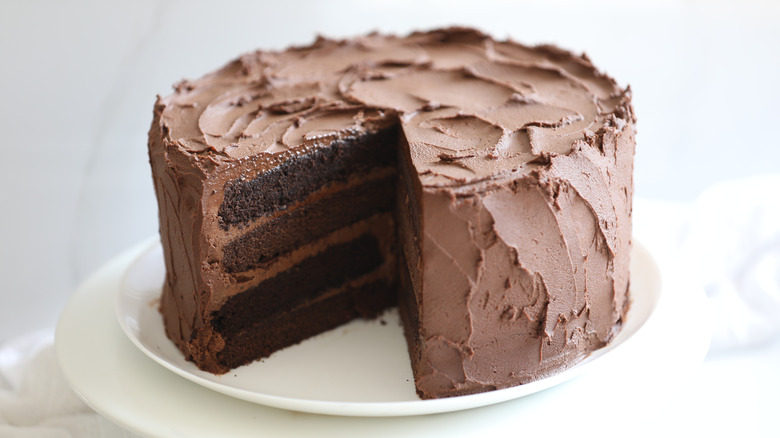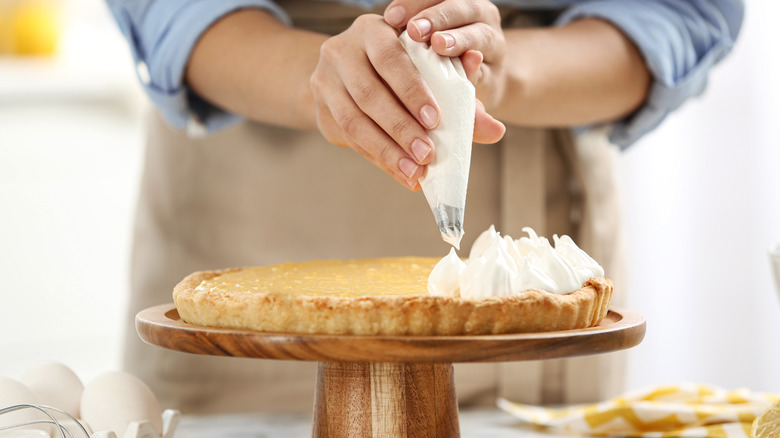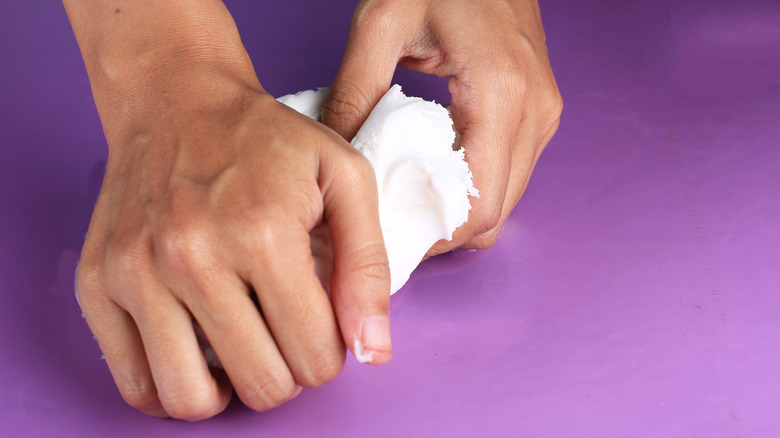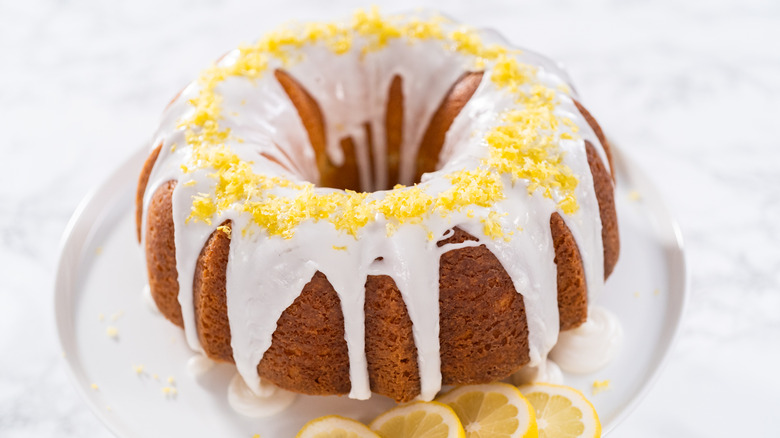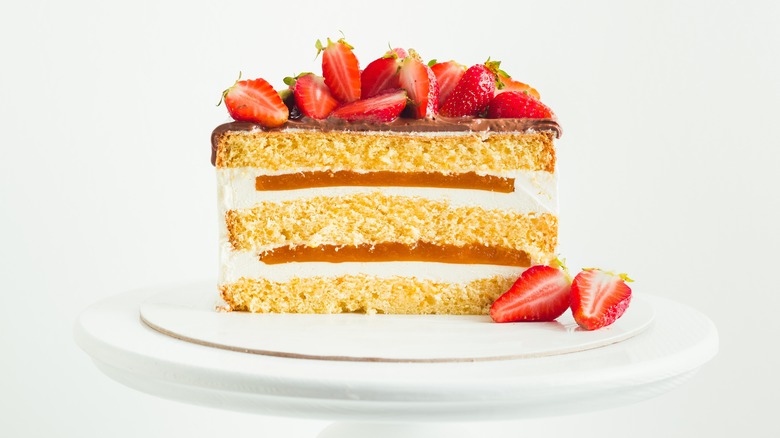17 Mistakes You're Making When Frosting Your Cakes
We may receive a commission on purchases made from links.
The experience of frosting a cake can be one of two things. The first is an outlet to express your creative side and show off your baking-show-worthy piping skills. Or frosting can be one of the most anxiety-inducing parts of baking that leaves you asking, "Can I just make it a naked cake?"
Like all parts of baking, frosting and decorating your cake is a matter of learning the techniques that work for you. We recommend always starting with a high-quality homemade frosting. There are many different types of frosting you can use depending on your recipe. If you're making a red velvet cake or a carrot cake, stick with a classic cream cheese frosting. If you need to decorate a cake in hot weather, you should try a decorator's buttercream — which is made with more stable vegetable shortening instead of butter.
Regardless of which kind of icing you use to decorate your cake, be sure to check out some of these tips and tricks for a smooth and flawless decorating experience.
Frosting a warm cake
Before you start frosting your cake, you need to run through a brief checklist to ensure your cake is ready to decorate.
You should never frost cakes before they're cool because it may result in the frosting sliding right off your cake. Per Betty Crocker, frosting a warm cake may also cause the outside of the cake to break and tear when you apply the frosting. Say goodbye to an even frosting coat!
The exact time you'll need to wait for your cake to cool is dependent on the size of the cake itself. If you want to expedite the process, you can put the cake in the fridge for a couple of hours to ensure that the cake is cool enough when you start to frost. If you notice your frosting is starting to get too melty, you can put your partially-frosted cake back in the fridge to allow it to harden.
Making ingredient substitutions
Most frosting recipes have a simple and direct recipe: fat, sugar, and a little bit of liquid. The more that you mess with your recipe components, the greater potential you have to mess up your frosting recipe. For example, the moniker "buttercream" implies that you have to use butter. You should never use a butter substitute for buttercream frosting because the butter will hold up better to frosting and decorating than other types of fats like oil and shortening.
Another common substitution many bakers make is granulated sugar in place of powdered sugar. This substitution can make your frosting grainy because the particle size of the granulated sugar is too large. Powdered sugar is fine enough to mesh with the butter and create a perfectly smooth frosting. And while you can make your powdered sugar by adding granulated sugar to a high-powered blender and pulsing until fine, we recommend just buying a bag at your grocery store for the smoothest possible texture.
Making frosting too far ahead of time
Haste makes waste, so why not get your frosting ready ahead of time? Think again. Since making frostings prematurely can cause issues with the texture and taste of your frosting, there is a limit to which frostings you can make ahead of time. You should make cream cheese frosting the same day as your cake, and make buttercream frosting no more than a day in advance. You should store your homemade frosting by covering it and keeping it in the fridge.
The outlet recommends adding a bit of icing sugar to thicken the icing or a bit of milk to thin the icing as needed. You should also plan to leave your frosting out of the fridge for one to two hours before you plan to frost your cake. This will ensure that your icing is soft and ready for piping when you start decorating.
Not leveling the cake
It shouldn't surprise you to know that your cake shouldn't be lopsided. Leveling your cake is important to reduce the dome-like shape that comes from baking. The domed part of the cake can be especially hard compared to the rest of the soft sponge, which is why it's important to keep the texture even throughout the cake. When you level your cake, you won't have to worry about the frosting or decorations sliding off to one side, and piping any writing on the cake will be much easier.
You can use a serrated bread knife and a rotating cake stand to trim your layers before you start frosting (via Baking Kneads). If you make a 1-inch incision in the cake, the outlet notes that you should be able to rotate the cake to cut it evenly.
Before you level your cake, you should always be sure that the cake is cooled all the way through. A warm cake is not stable enough and will drop if you try to cut it.
Forgetting to sift your powdered sugar
Powdered sugar is essential for many types of icing. According to Baking Nook, powdered sugar contains cornstarch. The cornstarch can absorb moisture, create clumps, and make your icing grainy. This is why it's important to sift your powdered sugar for a smooth frosting. Besides the grainy texture when you eat your slice of cake, you may also notice that the frosting gets stuck in the tip of your piping bag and refuses to come out.
You can sift your powdered sugar with a fine mesh sifter. Another useful tool to purchase is a stainless steel sifter with a silicon handle. When you pulse the handle, you'll find that the powdered sugar comes out a little more controlled than if you were to use a handheld sifter. When working with recipes, it's important to remember that you should always measure your powdered sugar after you sift it, since the air bubbles in pre-sifted sugar can create issues in the final weight of your powdered sugar.
Not using dowels to boost stability
We like our cakes to be edible — for the most part. But if you're making a cake that needs structural stability, you should consider using dowels to help stabilize your cake. Per Veena Azmanov, the dowels bear the weight of the cake rather than the bottom layer of the structure. The outlet notes that plastic dowels, PVC pipes, or strong wooden dowels are some of the most reliable types of dowels when it comes to stacking the cake. Some wooden dowels from craft stores won't sustain the weight of the cake. If you're making a lighter cake, you can also use thick boba straws as dowels.
Your cakes should always be chilled when you press in the dowel so it goes in straighter. Then, using your cake board, detail where the dowels are going to go. A ring of dowels, as well as a centered dowel, will prevent the cake from shifting when you move it.
Omitting a crumb coat
One of the first steps to frosting a layer cake is to apply a crumb coat. The crumb coat is a thin, protective layer of icing on the outside of the cake that prevents small pieces of the cake from crumbling off when you apply the regular layer of icing to the cake. The crumb coat will also ensure your cake is flat — this makes applying decorations and piping writing easier.
Before applying your crumb coat, make sure your cake is chilled. Then, use an offset spatula to spread a thin layer of frosting on the exterior of the cake. Since this icing will likely be filled with tiny crumbs, you should wipe off the spatula in a separate bowl before dipping it back into the fresh frosting. Then, allow your crumb coat to harden for about 20 minutes in the refrigerator before continuing to ice the rest of the cake.
Using cold store-bought icing for a sheet cake
Frosting a sheet cake can be a pain — especially when you have to get an even coating of icing in the corners of the cake. Instead of applying cold cake frosting to your sheet cake, the grocer Kroger instead recommends melting down your store-bought icing into a thinner texture (via TikTok). The video explains that you can either scoop the icing into a separate bowl and melt it down or keep it in the original container without the lid and melt the contents for 10 seconds. Once your frosting resembles a thick liquid, you can pour it on the cake, spread it with an offset spatula, and allow the cake to cool down to room temperature.
A home chef on the "Rachael Ray Show" notes you can use this hack for frosting layer cakes, too (via YouTube). She recommends adding a couple of drops of food coloring if you need colorful frosting for your special cake.
Using the wrong utensils to frost your cake
There are a ton of baking tools that all home bakers need to have. When it comes to frosting your cakes, you'll need to have an offset spatula handy. According to the King Arthur Baking Company, the offset spatula has a thin, flexible, rounded blade with a slight bend at the handle. This allows the baker's knuckle to be far away from the cake, and it will improve the ergonomic ease of frosting compared to a plain butter knife.
Once you're ready to smooth out the final layer of frosting to your cake, Los Angeles Times recommends dipping the blade of the spatula in hot water. Once you've removed your spatula from the water, dry it off with a towel and use the warmed blade to smooth out the frosting. Keeping the blade at an angle ensures only one side of the blade is covered in frosting, which will produce a more even layer (per Cake Art).
Omitting vinegar for smoothness
If you're making boiled frosting, such as seven-minute frosting or Italian meringue buttercream, you may find that the frosting tends to come out hard and often cracks when you go to cut it. But adding vinegar to your frosting can help keep it smooth and soft.
Vinegar is an ingredient that will improve the taste of your frosting too. The tartness of the white vinegar will contrast with the sweetness of the frosting and make a milder-tasting, less tooth-sickeningly sweet frosting. According to users at Cake Central, you can add vinegar to royal icing to speed up the drying process and set it firmer. The website also notes that you can use cream of tartar for the same effect.
When adding vinegar to your frosting, it's important to only add a teaspoon or less to your frosting (per The Washington Post). Adding too much vinegar to your frosting can create flavor issues and cause your frosting to go too sour.
Not adding a stabilizer
When you're working with frosting, it can be difficult to get your frosting to set and be stable. If the frosting is too loose, it will slide off the cake. If you dry out the icing too much, it will deviate too much from the fluffy frosting we know and love.
One of the ingredients you can add to the frosting to help keep it stable is marshmallow fluff. Buttercream frosting tends to melt or split easily since it contains butter, so adding a bit of marshmallow fluff to the mixture can help the mixture keep its stiff peaks and impart a nostalgic, vanilla flavor to the frosting.
Another ingredient to add to your frosting to help stabilize it is cornstarch. You can mix the cornstarch with a couple of tablespoons of milk to help thicken the frosting; it's an especially useful tool for hot days where buttercream would be otherwise runny.
Trying to fill your piping bag by hand
When it comes time to decorate your cake, you'll need to have a piping bag handy. It always seems difficult to fill the bag in your hand — and it usually ends up with your entire kitchen counter getting coated in a layer of buttercream.
Instead, you should fill your pastry bag by using a wide-mouth jar. Place the bottom of the bag in the jar and the top of your bag around the lip of the jar. Then you can fill the bag between two-thirds and three-fourths of the way full, twist the bag shut, and start piping. You should avoid overfilling your piping bag to the brim because it will make the bag harder to navigate and move it.
If you don't have a wide selection of tips for your pastry bag, you can instead use a plastic zipper storage bag to pipe a special message on your cake. Cut a small corner off the edge of your bag and pipe away.
Using the wrong ratio of frosting on a layer cake
Recipes don't give you much guidance on how much frosting to apply to each of your cake layers.
RecipeTips notes that a 6-inch round cake uses about 3 cups of frosting while a 6-inch square cake will need 3½ cups of frosting. Simply Recipes recommends applying between 4 and 5 cups of frosting on a two-layer cake and 5 to 6 cups on a three-layer cake. When it comes to layering, Simply Recipes notes that the baker should apply between ¾ and 1 cup of frosting on each layer of cake, with a little dollop on the cake stand to help the first layer stick.
Getting the perfect cake-to-frosting ratio is also about how you eat your cake. Food personality Duff Goldman notes that when you're eating your cake, you should try to use the back of your utensil like a frosting "reservoir" to ensure you get a little bit of frosting from the outer layer in each bite (via The Sporkful).
Not using whipped cream to practice your technique
If you've never used a piping bag, the day that you offered to make a wedding cake for your second cousin's in-laws is not the day to learn how. Instead, you need to practice your technique with a piping bag well before you make your first "real" cake.
Chef and food television personality Ina Garten recommends using a pastry bag and filling it with homemade whipped cream to practice your piping technique (via Barefoot Contessa). Whipped cream is a slightly easier type of frosting to learn how to pipe because it does not contain any heavy butter components. After you've learned how to navigate the piping bag, you can use your leftover whipped cream to top your coffee, ice cream, or sliced fruit.
Faye's Food recommends that if you can't get your hands on whipped cream, try shortening. Shortening has the same heavy consistency as buttercream but at a much lower price — both in ingredients and in time.
Not using fondant to craft unique designs and shapes
If you're trying to decorate special cakes for a celebration, you may want to add colorful flowers or cute snowmen. But before you pick up a piping bag, you should rethink what the most stable option is.
"Ace of Cakes" star Duff Goldman says that using gum paste to draw shapes with edible markers is the precursor to working with more tricky decorating tools. After you've mastered the gum paste trick, he says you can start using fondant to take your cake decorating to the next level. Fondant, unlike cream icing, is made from water, sugar, and corn syrup (per Bob's Red Mill). Rolled fondant has the texture of clay and can be either pushed into thin sheets to cover a cake or made into malleable shapes that can be used as decorations.
Goldman recommends novice fondant users start with making simple shapes, like a teddy bear, before moving up to other related shapes and figures. Eventually, your fondant library will be more endowed than when you started.
Using too many elaborate decorations for your cakes
Cake decorating is a fine line of fantastic, elaborate decorations as well as simple, modest designs. You should reconsider topping Bundt cakes with elaborate decorations because these cakes are already moist, dense, and flavorful without the addition of sweet buttercream. As long as you carefully remove the Bundt cake from the pan, you should have an ornate design that can be amplified by something as simple as a dribble of sugar syrup. Other cakes that are in the same boat are pound cake (since it weighs a lot already).
Instead of making icing, you should use powdered sugar to decorate your cake. Once your cake is cool, you can place a paper stencil on the cake to help add some artistic flair. America's Test Kitchen points out you should be sure your cake is thoroughly cooled, since warm cake may cause the powdered sugar to stick and form a syrup layer rather than a soft, snow-like ambiance (via YouTube).
Forgetting a border for a soft filling
Many bakers choose to add a jam or curd filling to their cake to add flavor and a new textural dimension. If you choose to add a layer of these ingredients to the center of your cake, you need to be sure to use your frosting as a barrier on the outside of the filling, per Cake by Courtney.
You need to first pipe a layer of icing on the cake, then pipe a layer on the outside edges, to prevent the filling from going over the edge or seeping into the delicate sponge. Cake by Courtney notes that you should err on the side of caution and apply more frosting than you'd think. Then you can add the filling.
You should also avoid adding too much filling to the cake; the website recommends ½ cup for a three-layer 8-inch cake, and about ¼ cup for a four-layer 6-inch cake. To finish, you should consider patching any spaces on the outside of the cake with frosting.
